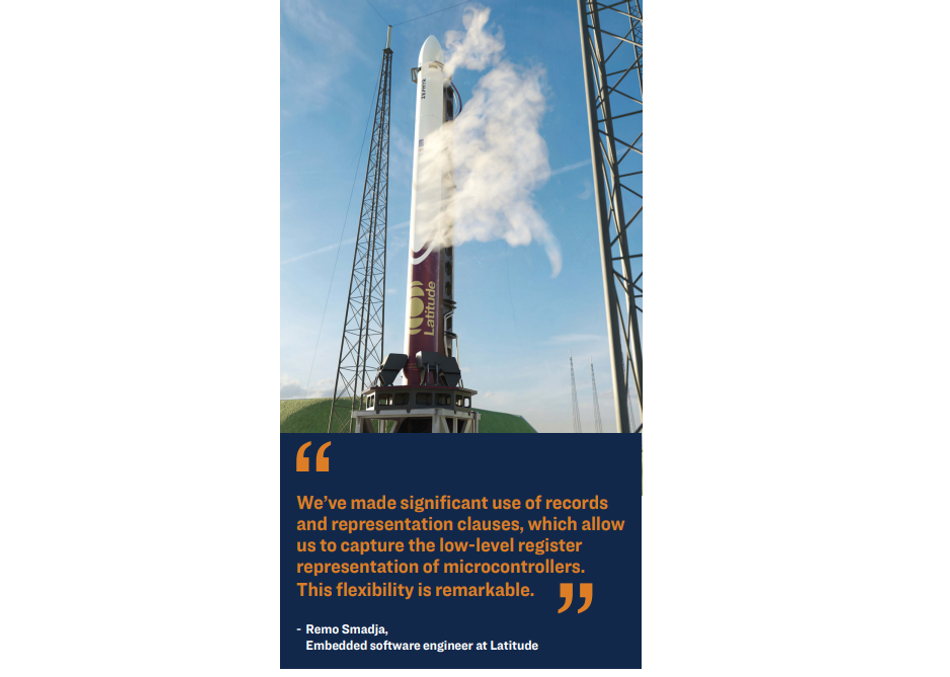Latitude Adopts Ada and SPARK for Light Launcher Software in New Space Industry
French company leverages AdaCore's tools, training, and mentorship services to produce flight software for small satellite launchers
This article was first published on
www.adacore.comChoosing Ada: Safety, Reliability, and Qualification
Headquartered in Reims, France, Latitude’s mission is to launch small satellites (up to 100 kilograms in Low Earth Orbit) for the European space market. To fulfill this mission the company is developing from the ground up a new launcher called Zephyr. Software is a vital element in this endeavor and the company’s core project involves developing and verifying the launcher flight code. The company was founded in 2019 with an engineering approach that combines a rich industrial heritage with advanced aerospace ingenuity. Their core project revolves around the flight software for the launchers, and a key decision – affecting the effort required in developing, verifying, and maintaining the code - was the choice of programming language, its supporting tools, and the tool vendor.
We write everything in Ada, from our own device drivers to the bare-metal programming of our business logic on microcontrollers.
- Clément Rousseau, embedded software engineer, Latitude
Among the various language technologies that Latitude investigated, Ada stood out as offering the best balance for the company’s needs. Perceived benefits included improved code quality, better safety support, and reasonable qualification cost. “We were drawn to Ada for its potential to simplify certification, even though it wasn’t a strict requirement when we began,” said Remo Smadja, Embedded software engineer at Latitude. “We expect our software to undergo certification in the future, most probably with some of the ECSS (European Cooperation for Space Standardization) standards.”
Ada and SPARK have been instrumental in helping Latitude meet its goals. “Ada’s high-level features combined with its systems programming support have been incredibly beneficial,” said Mr. Smadja. “We’ve made significant use of records and representation clauses, which allow us to capture the low-level register representation of microcontrollers. This flexibility is remarkable.” Latitude’s decision to write its entire software in Ada reflects its trust in the language’s safety, reliability, and efficiency. “We write everything in Ada, from our own device drivers to the bare-metal programming of our business logic on microcontrollers,” said Clément Rousseau, embedded software engineer at Latitude. Latitude’s current software strategy prioritizes simplicity and efficiency, and leverages GNAT Pro’s included real-time tasking run-time for safe concurrency. The team found particular benefits in using the Ravenscar profile, a subset of Ada’s concurrency features supported by the certifiable light-tasking runtime profile. “The Ravenscar profile fits our needs perfectly at this point,” said Mr. Rousseau. “Our strategy is to keep everything as straightforward as possible.” By eliminating the need for a complex operating system, Ravenscar has streamlined task analysis and boosted the team’s confidence in mitigating concurrencyrelated issues.
AdaCore’s GNAT Pro and GNAT Studio form the core of Latitude’s development environment, additionally, the SPARK language and the SPARK Pro tool suite are used for critical code sections.

AdaCore’s Support: Navigating the Transition to Ada
Latitude’s software developers, although experienced in C, C++, and Java, were not formally trained to Ada at the outset of the project. Understanding Ada’s rich set of features and knowing how to use them effectively were therefore critical skills that the team needed to acquire. To meet this goal, Latitude decided in late 2021 to invest in the training and mentoring services that AdaCore offers. AdaCore conducted classes that included hands-on workshops, which provided customized guidance on how to best use Ada’s safe coding practices. After rapidly becoming proficient in Ada, the team readily made the transition to SPARK for critical code sections.
The mentorship was instrumental during Latitude’s software development. Initiated while the code architecture was still being designed, AdaCore’s consultation helped the team employ Ada’s best practices in refining the code structure. Mentorship discussions covered topics ranging from design patterns to code analysis techniques such as stack checks. Latitude found the GNAT Pro compiler especially useful; it performs many checks that would have required the use of separate analysis tools in the case of deploying other languages.
Future Outlook: Conquering the “New Space Industry”
Looking ahead, Latitude remains keenly focused on the development of Zephyr’s flight software. In addition, the company plans to continue leveraging Ada and SPARK for future projects. In the rapidly changing landscape of European space startups, companies are always looking to stand out from the crowd. For software, that means implementing innovative functionality through code that is safe, secure, reliable, efficient, and easily maintainable as requirements evolve. Latitude believes in modern programming language technology, backed by AdaCore’s effective professional support, to help them meet their goals.

